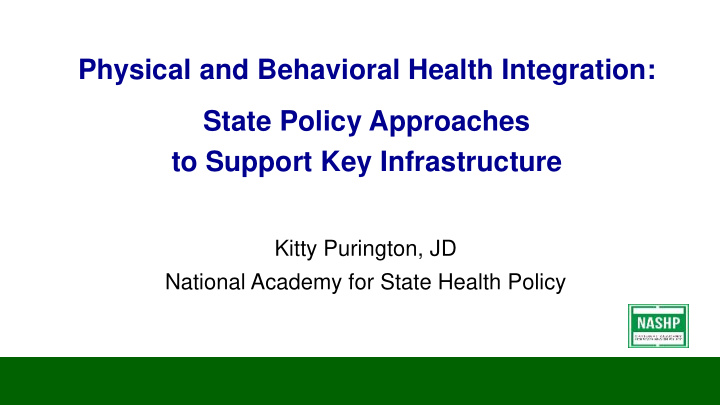



Physical and Behavioral Health Integration: State Policy Approaches to Support Key Infrastructure Kitty Purington, JD National Academy for State Health Policy
New NASHP Issue Brief In this brief, NASHP: Reviews the emerging consensus across integrated care models and approaches, Identifies common components of integrated care infrastructure Highlights how leading states support this infrastructure using diverse policy strategies.
Background Integrated care: important issue for states Key part of major reform efforts: SIM, DSRIP, Health Homes Many definitions, models Unique needs of state policymakers: Systems approach Diverse settings, populations Need for adaptable, functional approach
Diverse Approaches… 2014 National Committee for Quality Assurance Patient- Centered Medical Home Standards Agency for HealthCare Research and Quality Integration Academy: Lexicon for Behavioral Health and Primary Care Integration Medicaid Health Homes: required elements Collaborative Care Core Principles
…Common Themes Key Components: Multi-disciplinary teams A systematic approach to care using population-based tools, clinical guidelines, and/or evidence-based practices Care management and care coordination, including care transitions Use of health information technology Quality measurement and improvement
State Strategies to Support Infrastructure Leverage Medicaid Variety of Medicaid options for key service components: team-based care care management/care coordination population-based health strategies
Medicaid: Options for Integrated Care Authority Payment Flexibility State Example Health Homes Population-based PMPM Rates Connecticut: Behavioral Health Homes Cost-based Monthly Case Rates Missouri: Primary Care Health Homes Fee-for-Service Primary Care Population-based PMPM Rates Idaho: Healthy Connections Case Performance-based Payments Management Managed Care Capitation to plans, which may in turn develop alternative payment Idaho: Idaho Behavioral Health Plans arrangements for providers (including population-based PMPM or performance-based payments). Medicaid Broad authority to test alternative payment methodologies. Arizona: Health Care Cost Containment Demonstration System Regional Behavioral Health Projects Agencies State Plan Varies by service, but may include direct reimbursement for relevant Georgia: Whole Health Peer Program Services providers and services (e.g., peer recovery supports; Health Behavior and (Rehabilitative Services Option) Assessment Intervention services).
State Strategies: Provider Requirements State Medicaid regulation, payment options Major vehicles: Health homes, behavioral health homes 2014 PCMH standards DSRIP Initiatives
State Strategies: Training and Workforce Development Learning collaboratives Training resources New workforce development: community care teams, integrated peer models, psychiatric consultation Scope of work review
State Strategies: Data Infrastructure for Behavioral Health States taking leadership role in developing BH data capacity: Providing guidance, use cases for BH providers Funding connections to HIE Supporting population-based, integrated data tools Facilitating exchange through universal consent forms/technical assistance Support for Direct technology
Other Leverage Points Supporting administrative changes: unifying licensing requirements reviewing silo’d internal structures Managed Care Contracting
Recommend
More recommend